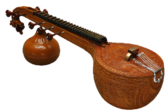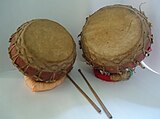| Indian classical music |
|---|
 |
| Concepts |
Vadya (Sanskrit: वाद्य, vādya), also called vadyaka or atodya, is one of the three components of sangita (musical performance arts), and refers to "instrumental music" in the Indian traditions.[1][5][6] The other two components of sangita are gita (vocal music, song) and nritya (dance, movement).[1][7][4] In the general sense, vadya means an instrument and the characteristic music they produce, sound, or play out.[8][9]
- ^ a b c Lewis Rowell (2015). Music and Musical Thought in Early India. University of Chicago Press. p. 13. ISBN 978-0-226-73034-9.
- ^ Bigamudre Chaitanya Deva (1995). Indian Music. Taylor & Francis. pp. 95–96. ISBN 978-81-224-0730-3.
- ^ Rachel Van M. Baumer; James R. Brandon (1993). Sanskrit Drama in Performance. Motilal Banarsidass. pp. 117–118. ISBN 978-81-208-0772-3.
- ^ a b Alison Arnold; Bruno Nettl (2000). The Garland Encyclopedia of World Music: South Asia : the Indian subcontinent. Taylor & Francis. pp. 19–20. ISBN 978-0-8240-4946-1.
- ^ Cite error: The named reference
mmwvadyawas invoked but never defined (see the help page). - ^ Cite error: The named reference
Barthakur2003p3was invoked but never defined (see the help page). - ^ Jaap Kunst (2013). Hindu-Javanese Musical Instruments. Springer Science. pp. 88 with footnote 26. ISBN 978-94-011-9185-2.
- ^ Lewis Rowell (2015). Music and Musical Thought in Early India. University of Chicago Press. pp. 113–114. ISBN 978-0-226-73034-9.
- ^ Mandakranta Bose (2012). Movement and Mimesis: The Idea of Dance in the Sanskritic Tradition. Springer Science. p. 57. ISBN 978-94-011-3594-8.
© MMXXIII Rich X Search. We shall prevail. All rights reserved. Rich X Search




